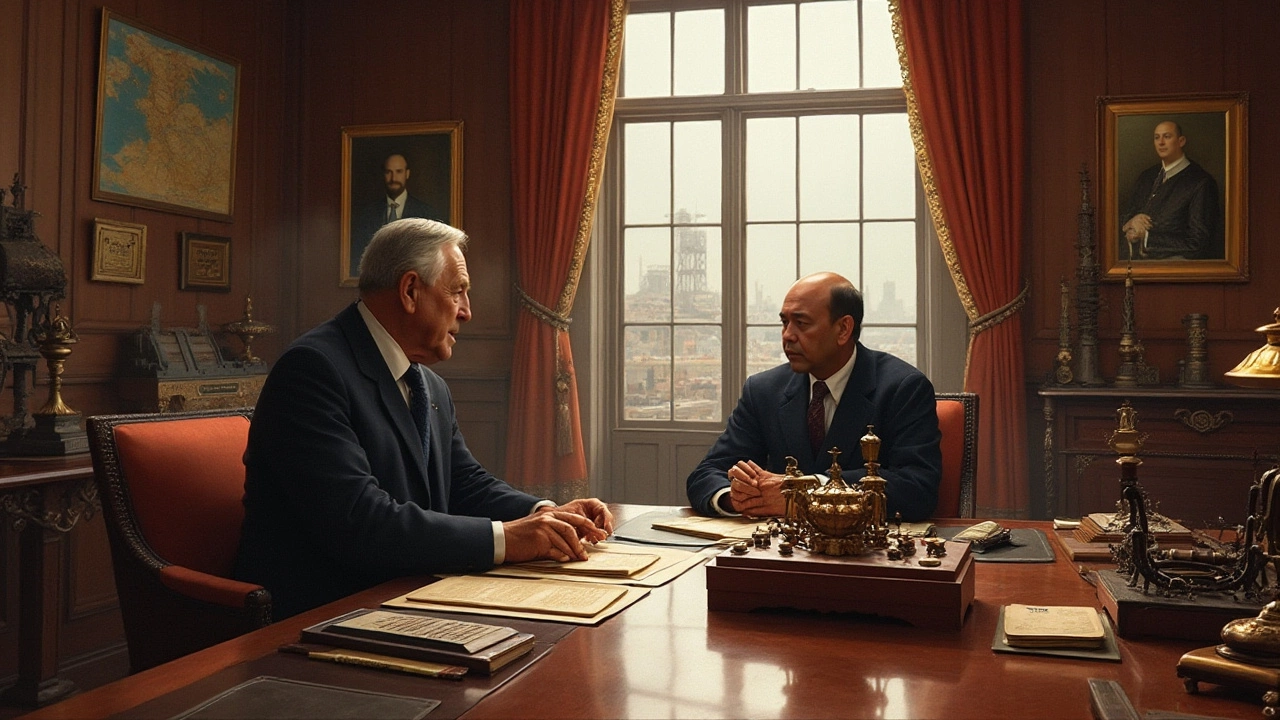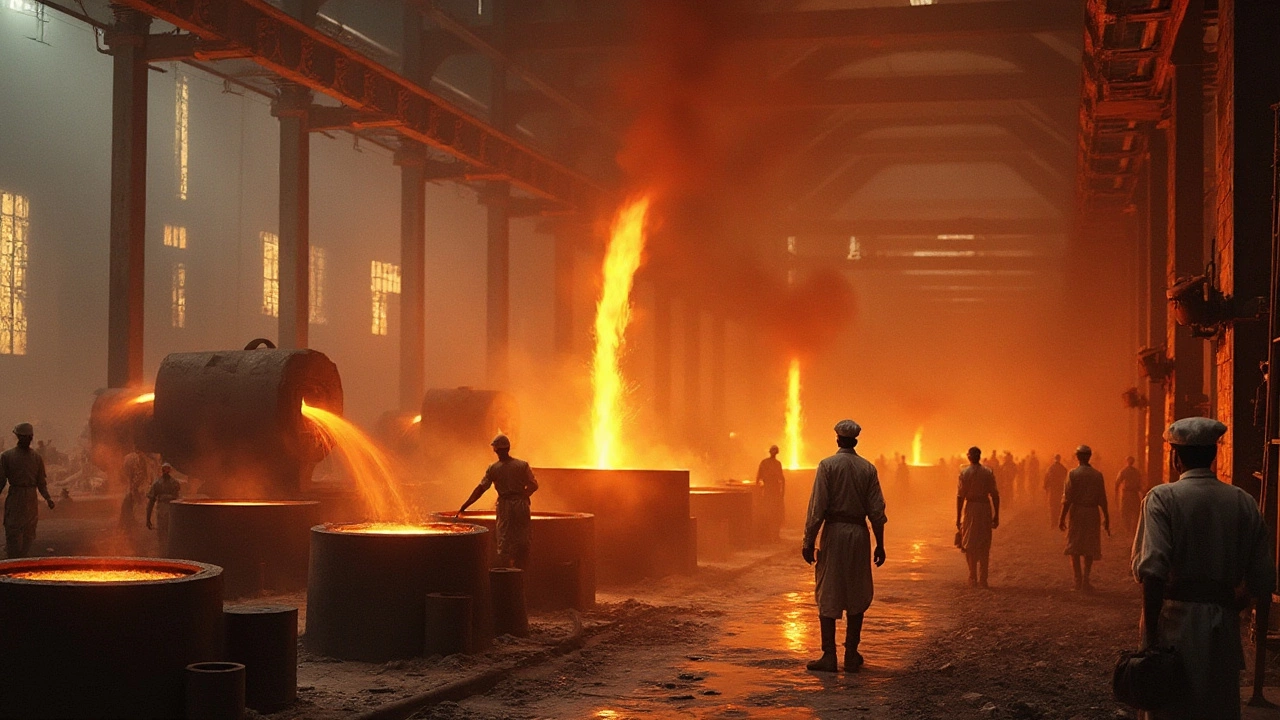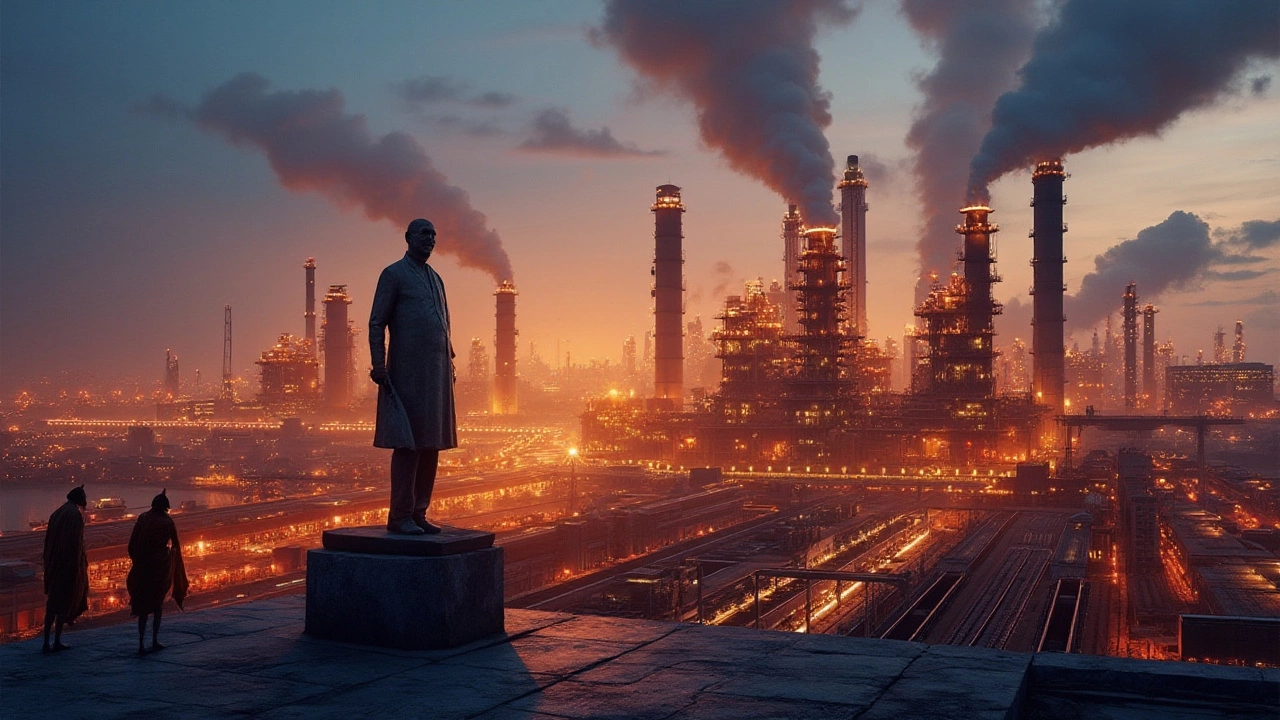The realm of steel manufacturing, a foundation of modern infrastructure, has witnessed towering figures whose wealth redefined the industry. These individuals wielded both power and fortune, creating legacies through their business acumen and strategic maneuvers. Amid the smoke and sweat of the steel mills, legends like Andrew Carnegie emerged, crafting a story more glittering than the steel they produced.
In the contemporary era, Lakshmi Mittal's narrative unfolds, weaving modernity with traditional industrial prowess, marking a chapter in the global steel saga. Each figure brought something unique to the table, changing how the world viewed this vital metal. Their stories are not just about wealth, but about innovation and the indomitable human spirit to transform landscapes, economies, and lives.
- Introduction to Steel Industry Giants
- Andrew Carnegie: Pioneer of Steel Wealth
- Lakshmi Mittal: Modern Steel Magnate
- The Impact of Wealth on the Industry
- Lessons from the Legends
Introduction to Steel Industry Giants
The steel industry, integral to our skyscrapers and bridges, has seen titans whose influence resonates beyond the smelting furnaces. These giants not only shaped business empires but also transformed societies. The emergence of these figures began in the late 19th century when demand for steel soared as nations raced to industrialize. At the forefront, individuals like Andrew Carnegie leveraged this opportunity, positioning themselves at the helm of innovation and financial acumen.
Carnegie's ascent in the industry was not one of mere chance. Born in Scotland and emigrating to the United States without wealth, he climbed the ranks through sheer determination and strategic thinking. His philosophy was simple yet groundbreaking: reduce the cost of steel production while increasing quality and efficiency. This approach allowed him to dominate the market, setting the stage for others to follow in his footsteps. It was once said, "Carnegie has been an artful gardener of his own remarkable growth," highlighting his ability to not only grow wealth but also cultivate industrial advancements.
Moving into the modern age, the narrative of the richest men in steel veers toward figures like Lakshmi Mittal. Operating on a global scale, Mittal's empire expanded through strategic mergers and acquisitions, creating a network of steel plants that spanned continents. His approach differed from his predecessors; he sought to consolidate the fractured industry, believing that a unified approach would yield greater efficiencies. Today, ArcelorMittal, the world's largest steel manufacturer, stands testament to his vision.
The stories of these industry leaders emphasize not only their ability to amass wealth but their foresight to push the boundaries of what was thought possible in steel manufacturing. They set standards and processes that are still used as benchmarks today. As we delve deeper into the lives and strategies of these giants, one cannot help but appreciate their role in laying the bedrock for modern civilization. The steel industry, with all its challenges and triumphs, continues to evolve, greatly inspired by the legacies of its most extraordinary figures.
Illustrating this, a closer look at their financial prowess reveals fascinating insights. A critical aspect of their success was understanding market demands and adjusting their business models accordingly. During the early 20th century, the demand for steel in the construction of railroads and buildings in the US only magnified this effect, placing steel magnates at an advantageous economic position. Their ability to predict these trends was not mere luck—it was the hallmark of their sharp business acumen, wherein they consistently made decisions that steered them towards unprecedented growth and development.
Andrew Carnegie: Pioneer of Steel Wealth
Andrew Carnegie's story is one of grit, vision, and an unparalleled drive that redefined the steel industry in the late 19th century. Born to a humble family in Scotland in 1835, Carnegie immigrated to the United States as a child, seeking better opportunities. His journey from bobbin boy earning a few cents a week to becoming the wealthiest man in the steel industry is both awe-inspiring and instructional. By the 1880s, Carnegie had seen the potential of the Bessemer process, which revolutionized steel production by reducing costs and increasing output. He strategically invested in the process, laying the groundwork for what would eventually become the Carnegie Steel Company. This boldness paid off handsomely; by the turn of the century, his company was one of the largest and most successful in the world.
Carnegie was not just a businessman; he was a visionary who foresaw the railroad's expansion and created a vast supply chain, ensuring that his steel manufacturing plants were optimally connected and supplied. This network allowed him not only to maximize efficiency but also to control pricing, keeping competitors at bay. In 1901, Carnegie saw an opportunity to sell his empire to the newly formed United States Steel Corporation for a staggering $480 million, a deal orchestrated by J.P. Morgan. This sale not only marked the end of his active involvement in the industry but also positioned U.S. Steel as the world's first billion-dollar corporation, a testament to Carnegie's legacy.
Driven by a belief in philanthropy, Carnegie often spoke about the responsibility of the wealthy to use their resources for the greater good. His famous quote,
"The man who dies thus rich dies disgraced,"resonated with many and underscored his dedication to giving back. True to his word, in his later years, Carnegie donated over $350 million, funding libraries, education, and scientific research, leaving a legacy beyond his industrial magnate status. His approach to wealth and distribution provides an enduring lesson on balancing personal success with social responsibility—an ethos that has influenced countless entrepreneurs since.

Lakshmi Mittal: Modern Steel Magnate
Lakshmi Mittal's journey to becoming one of the most influential figures in the steel industry is nothing short of extraordinary. Born in 1950 in Sadulpur, Rajasthan, India, Mittal had humble beginnings in a small village without basic amenities. His early experiences shaped his highly adaptive and shrewd business sense. In the early 1970s, after graduating from the University of Calcutta, he joined his family's burgeoning steel business which, at the time, was quite modest. However, Mittal soon realized the potential of the industry and began his pursuit of success on a much larger scale.
In 1976, amid the economic challenges of post-independence India, he ventured out to establish his first steel factory in Indonesia, where the environment was ripe for industrial growth. This move proved pivotal, laying the foundation for what would become the world's largest steel-making entity. Mittal Steel Company was officially formed in 1989, marking the beginning of an era defined by aggressive expansion and relentless ambition. This strategic decision was the catalyst for further acquisitions across Kazakhstan, Germany, and the United States, allowing Mittal to gain a strong foothold in the global market.
By the early 2000s, Lakshmi Mittal had become a formidable name in steel manufacturing, coinciding with significant growth in demand driven by burgeoning economies, particularly China. This period saw Mittal Steel acquire Arcelor, one of Europe's biggest steel firms, in a landmark deal worth $33 billion. This acquisition in 2006 resulted in ArcelorMittal, the largest steel producer, cementing Mittal's legacy as a true modern steel magnate. To put things into perspective, his company produced about 10% of the world's steel at its zenith.
Mittal's leadership style was characterized by a keen eye for opportunity and a penchant for operational efficiency. Yet, it wasn't just his business acumen that earned him respect but also a commitment to philanthropy. His establishment of the Mittal Champions Trust to support Indian athletes and funding of a $15 million sports complex in London are testament to his enduring impact beyond business. Mittal's influence extends into politics and economics, and in many ways, epitomizes the interconnectedness of global industry today.
Lakshmi Mittal once said, "Always think outside the box and embrace opportunities that appear, wherever they might be." This philosophy underscores his journey of audacity and foresight.
In today's context, Lakshmi Mittal remains a symbol of wealth within the industrial sector, continually shaping strategies that reflect a keen understanding of global markets and innovative approaches. According to Forbes, as of 2023, his net worth hovered around an impressive $20 billion, reflecting his status as one of the richest in the steel domain. His success isn't just encapsulated in figures but is mirrored in the thousands of employees worldwide and the advancements in sustainable practices he endorses.
| Year | Major Achievement |
|---|---|
| 1989 | Founded Mittal Steel |
| 2006 | Acquired Arcelor to form ArcelorMittal |
| 2023 | Net worth estimated at $20 billion |
The Impact of Wealth on the Industry
The influx of immense wealth into the steel industry has undeniably altered its course and operations. For many years, financial capital served as both a driving force and a disruptor, reshaping traditional practices. The power of wealth allowed industry titans like Andrew Carnegie and Lakshmi Mittal to not only expand their personal empires but also accelerate technological advancements within steel manufacturing plants. Financial resources fuelled innovation, enabling the transition from manual labor-intensive processes to more efficient, automated production methods.
Wealth gave these steel magnates the leverage to acquire strategic assets, vertically integrating their operations to enhance efficiency and reduce costs. They invested in cutting-edge technologies, significantly improving output and quality while minimizing waste. The capital also allowed for acquisitions and mergers, creating conglomerates with the scale to dominate global markets. For instance, Lakshmi Mittal's aggressive acquisition strategy led to the formation of ArcelorMittal, now one of the world's largest steel producers.
Notably, substantial wealth also equipped these magnates to influence policies, often advocating for tariffs and regulations that favored industrial growth. Their financial power enabled them to wield tremendous political sway, ensuring a business environment conducive to expansion. This accumulation of influence and capital did not only alter market dynamics but shifted the geographical focus of steel production, emphasizing areas where competitive advantage and resources aligned.
Through this wealth, influential figures in the steel industry were able to create vast networks of stakeholders, fostering collaborations across industries. Their fortunes facilitated partnerships with governments and key players in construction, manufacturing, and beyond. Such collaborations cemented their status as indispensable cogs in the wheel of industrial and economic development. By doing so, they didn't just grow their wealth—they built a legacy that tracks back to substantial job creation, infrastructure development, and enhanced living standards worldwide.
"Steel is the backbone of our economy, and those who've harnessed its power lead us into the future," remarked a senior editor at The Economist, highlighting the critical role wealth plays in steering the industry.
In essence, the wealth amassed within the steel industry has not only shaped the trajectory of individual players but has transformed the landscape of the industry itself. These steel moguls have leveraged their fortunes to irrigate the seeds of innovation, expansion, and influence. Their contributions go beyond personal profit margins; they lay the groundwork for a future paved in steel, resilient yet adaptable to the ever-evolving demands of global economies and societies.

Lessons from the Legends
The giants of the steel industry have left behind invaluable lessons not just for aspiring tycoons but for anyone intrigued by the art of turning challenge into opportunity. Andrew Carnegie, once a poor immigrant boy, demonstrated the sheer power of vision and tenacity. His story teaches that wealth isn't just about what you earn, but how you invest that earnings in future growth. Carnegie understood the importance of vertical integration — owning everything from the raw materials to the transportation needed for his iron and steel manufacturing empire. This meticulous control minimized costs and maximized quality, setting a standard for efficiency previously unseen.
On the other hand, Lakshmi Mittal, with a journey that spanned across continents, shows the strength found in globalization and consolidation. In a world that seemed increasingly splintered, Mittal saw unity as his key. By acquiring struggling steel plants globally, he not only expanded his business but also revitalized dying industries, giving thousands jobs and hope. His belief in shared strength is echoed in his statement,
"Integrating, not just contacting, is the way to sustain development."His success underscores the idea that vision must be flexible, adaptable to changes in the economic and global landscape, yet unwavering in its core goals.
These legendary figures both emphasized the importance of reinvestment. Carnegie famously declared that "the man who dies rich, dies disgraced," choosing to donate much of his fortune to educational and cultural institutions. This act of giving back fostered a legacy that transcended traditional measures of success. Similarly, Mittal has focused on philanthropic pursuits, ensuring that education and healthcare improvements accompany his business footprints worldwide. Their lives bring to light the power of leveraging wealth not as an endpoint but as a means to effect positive change, thus reinforcing the value of social responsibility entwined with financial growth.
